
Antenna
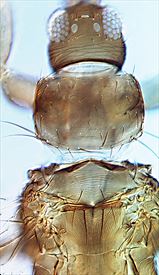
Head & thorax
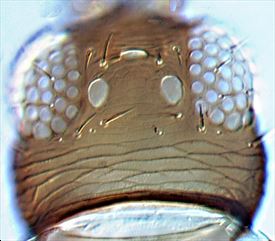
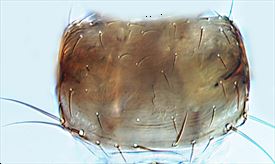
Pronotum
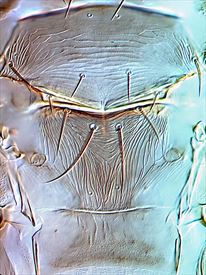
Meso & metanotum

Fore leg
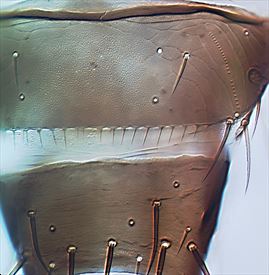
Female tergites VIII-IX
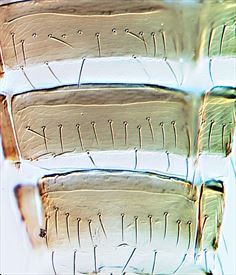
Female sternites V-VII

Male sternites and pore plates
Distinguishing features
Both sexes usually fuly winged. Female variable, usually pale to dark brown, but sometimes yellowish; tarsi, apices of tibiae, and pedicel of antennal segment III often yellow, segment III varies from dark brown to yellowish brown, rarely yellow in basal half; fore wing pale basally, shaded in distal four-fifths; major setae dark. Head wider than long; ocellar setae III on anterior margins of ocellar triangle. Antennae 7- or 8-segmented; III and IV each with a forked sense cone. Pronotum with 3 pairs of posteromarginal setae. Metanotum longitudinally striate medially, transversely striate at anterior; median setae close to anterior margin. Fore wing with both setal rows complete. Tergites II–V with lines of sculpture not continuous medially; VIII with posteromarginal comb variably complete or irregular; tergite IX with 2 pairs of campaniform sensilla. Pleurotergites and sternites with a transverse row of discal setae; sternite VI with 6–14 discal setae.
Micropterous female with wing lobe usually shorter than pterothoracic width; metanotal sculpturing less regular than in macroptera.
Male similar to female but yellow with antennal segments III–VII brown. Sternites III–VII with a transversely oval median pore plate. Micropterous male yellow, with antennae and apex of abdomen brown, or as brown as female; sternal pore plates about 4 times as wide as long.
Related species
There are 13 species of the genus Thrips recorded from New Zealand, of which five comprise an endemic group, out of a total of 280 species worldwide (Mound & Masumoto, 2005). All members of Thrips genus have paired ctenidia on the tergites, and on tergite VIII these are postero-mesad to the spiracles, and these species also lack ocellar setae pair I in front of the first ocellus. In contrast, Frankliniella species have ctenidia on tergite VIII antero-lateral to the spiracles, and a pair of setae is always present in front of the first ocellus. T. obscuratus is one of the five New Zealand endemic members of this genus that share the presence of three pairs of posteromarginal setae on sternite II, and have both fore wing veins with a complete row of setae, and the abdominal pleurotergites and sternites with discal setae. Particularly closely related to obscuratus is Thrips merae from Norfolk Island (Mound & Wells, 2015).
Biological data
Feeding and breeding in flowers, larvae of this highly polyphagous thrips have been recorded from 50 different plant species, and adults recorded from over 200 plant species in 78 families (Teulon & Penman, 1990). Adults are found throughout the year in flowers and on leaves of introduced and native plants, as well as in samples from litter, birds' nests, and moss.
Distribution data
Known only from New Zealand where it is widespread and common throughout the year.
Family name
THRIPIDAE, THRIPINAE
Species name
Thrips obscuratus (Crawford JC)
Original name and synonyms
Isoneurothrips obscuratus Crawford JC, 1941: 63
References
Mound LA & Masumoto M (2005) The genus Thrips (Thysanoptera, Thripidae) in Australia, New Caledonia and New Zealand. Zootaxa 1020: 1–64
Mound LA & Walker AK (1982) Terebrantia (Insecta: Thysanoptera). Fauna of New Zealand 1: 1–113.
Mound LA & Wells A (2015) Endemics and adventives: Thysanoptera (Insecta) Biodiversity of Norfolk, a tiny Pacific Island. Zootaxa 3964 (2): 183–210.
Teulon DAJ & Penman DR (1990) Host records for the New Zealand flower thrips (Thrips obscuratus (Crawford) Thysanoptera: Thripidae). New Zealand Entomologist 13: 46–51.